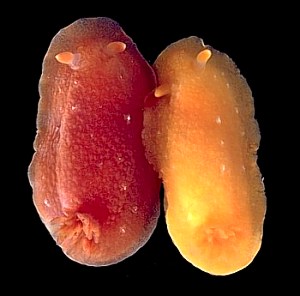
Doriopsilla carneola
(Angas, 1864)
Order: NUDIBRANCHIA
Suborder: DORIDINA
Superfamily: EUDORIDOIDEA
Family: Dendrodorididae
DISTRIBUTION
Southern Australia, from New South Wales to Western Australia.
PHOTO
UPPER RIGHT: Port Arlington, Port Phillip Bay, Victoria, April 1980.
LOWER LEFT: Eyre Penin., South Australia, February 1985, on sponge 48mm long.
LOWER RIGHT: A, Northern Tasmania, Feb 1984, 25mm long. B, Northern Tasmania, Feb 1984, 20mm long. C, Eyre Penin., South Australia, Feb 1985, 54mm long. PHOTOS: Bill Rudman.
Ranges in colour from translucent white to deep wine red. Usually has a few white patches, sometimes in a line down each side of thr mantle, but often no white is present. The mantle is relatively firm and covered in microscopic tubercles.
Compare with Dendrodoris citrina, Doriopsilla miniata and Doriopsilla aurea.
Note added 2 Feb 2005: previously called Dendrodoris carneola on Forum
- Angas, G.F. (1864) Description d'especes nouvelles appartenant a plusieurs genres de Mollusques Nudibranches des environs de Port-Jackson (Nouvelle-Galles du Sud), accompagnee de dessins faits d'apres nature. Journal de Conchyliologie 12: 43-70.
-
Burn, R.F. (1962) Notes on a collection of Nudibranchia (Gastropoda: Dorididae and Dendrodorididae) from South Australia with remarks on the species of Basedow and Hedley, 1905. Memoirs of the National Museum of Victoria, 25: 149-171.
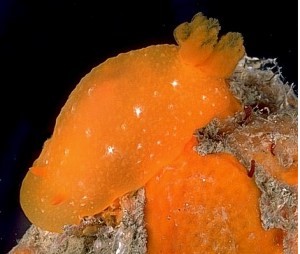
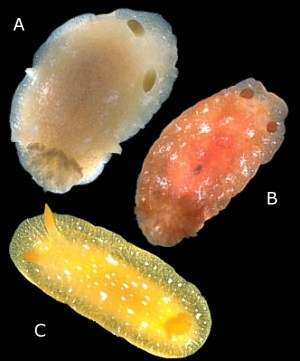
Rudman, W.B., 2000 (March 14) Doriopsilla carneola (Angas, 1864). [In] Sea Slug Forum. Australian Museum, Sydney. Available from http://www.seaslugforum.net/find/dendcarn
Related messages
Doriopsilla carneola from Sth Australia
January 10, 2007
From: David S. Muirhead
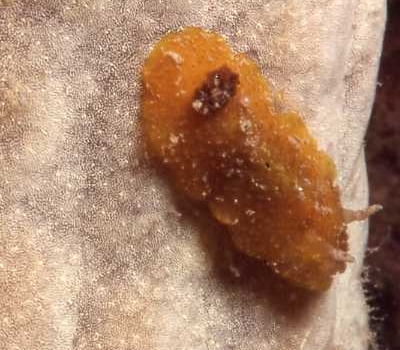
Dear Bill,
Please ID this nudi - Likely common species,?colour variant of,only?
Locality: Kingscote Jetty, Kangaroo Is., 4 metres, South Australia, Australia, 04 July 2006, pylon near bottom,heavy invert. cover. Length: 30 mm approx. Photographer: David Muirhead.
Regards,
David
dmuirhea@bigpond.net.au
Muirhead, D.S., 2007 (Jan 10) Doriopsilla carneola from Sth Australia. [Message in] Sea Slug Forum. Australian Museum, Sydney. Available from http://www.seaslugforum.net/find/19034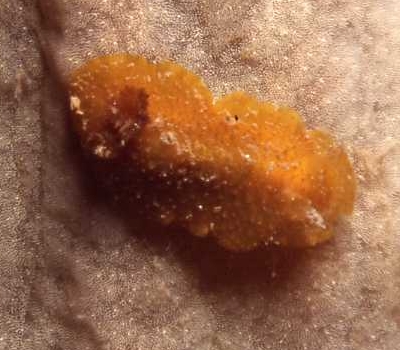
Dear David,
I am pretty sure this is Doriopsilla carneola, which is very variable in colour. Its nice to see it on a sponge, which may turn out to be its food sponge. Interestingly the white specks on the mantle seem to mimic the whhite specks on the sponge. It may be a complete coincidence, but may be worth looking out for in the future.
Best wishes,
Bill Rudman
Doriopsilla carneola? from Port Phillip Bay, Australia
April 15, 2006
From: Martina Fuchsberger
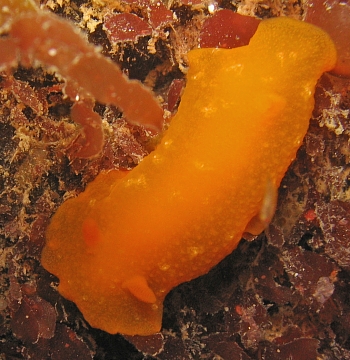
Dear Bill,
I found a number of these Nudis on my last nightdive. I think they might be Doriopsilla carneola, but I am not sure. Can you confirm this ID, please?
Locality: Portsea Pier, 4m, VIC, Australia, Port Phillip Bay, 29 March 2006. Length: approx. 50mm. Photographer: Martina Fuchsberger.
Cheers,
Martina
fuchsberger@gmail.com
Fuchsberger, M., 2006 (Apr 15) Doriopsilla carneola? from Port Phillip Bay, Australia. [Message in] Sea Slug Forum. Australian Museum, Sydney. Available from http://www.seaslugforum.net/find/16315Dear Martina,
I'm pretty sure this is Doriopsilla carneola. As you will know there are some other similarly coloured species in southern Australia, but the white marks and fairly hidden tubercles are typical of D. carneola.
Best wishes,
Bill Rudman
Doriopsilla carneola from Port Phillip Bay, Australia
March 30, 2006
From: Bill van Eyk
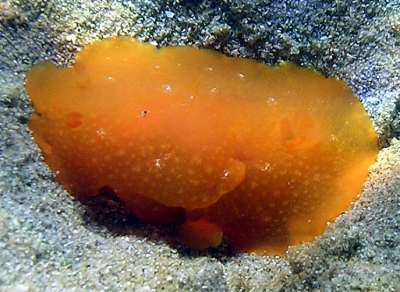
Hard to see detail due to bright orange colour. It was crawling through bare sand away from vegetation. Probably on the way to a feed.
ID thanks to Brad Loy an avid "sea-slugger".
Locality: Blairgowrie breakwater pier, 2 metres (~ 7 ft), Victoria, Australia, Port Phillip Bay, 16/03/06, Sandy, shallow subtidal, under pier, clear. Length: 2 cm (0.8 in). Photographer: Bill van Eyk.
Bill van Eyk
vaneyk@vegas.com.au
Van Eyk, W., 2006 (Mar 30) Doriopsilla carneola from Port Phillip Bay, Australia. [Message in] Sea Slug Forum. Australian Museum, Sydney. Available from http://www.seaslugforum.net/find/16181Thanks Bill,
Yes I agree with the identification
Best wishes,
Bill Rudman
Doriopsilla carneola with eggs, Tasmania
March 24, 2006
From: Robin Thomson
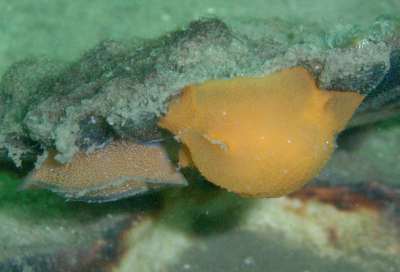
A dive buddy photographed this nudi while on a recreational scallop dive. We see lots of them when diving on the scallop beds in the D'entrecasteaux Channel between Bruny Island and Tasmania, near Hobart, Australia. We're 99% certain they are Doriopsilla carneola. This one is in 7.5 m of water and was about 55 mm long. They also come in red and lime yellow shades but the vast majority are this orange colour. My buddy also found some at the bottom of a 30 m deep trench in the Channel. It is next to and had probably just finished laying a string of eggs inside an old, dead, scallop shell.
Locality: Dentrecasteaux channel, Hobart, 7.5 m, Australia, Southern ocean, 18 March 2006, Muddy, silty. Length: 55 mm. Photographer: Mitchell Rolls.
Robin Thomson
robin.thomson@csiro.au
Thomson, R.B., 2006 (Mar 24) Doriopsilla carneola with eggs, Tasmania. [Message in] Sea Slug Forum. Australian Museum, Sydney. Available from http://www.seaslugforum.net/find/16153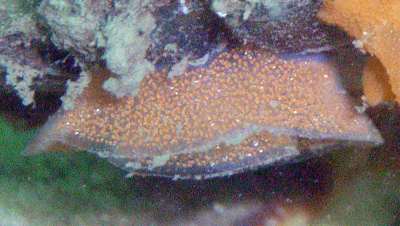
Dear Robin,
I agree with your identification, and since we know the egg ribbon of Doriopsilla carneola, from Bob Burn's work (Burn, 1989), I can say this animal is most likely the proud parent. In this species the eggs are quite large and the young hatch out, not as small swimming veliger larvae, but as slightly larger (about 0.8 mm long) crawling slugs. If you see these animals regularly, it might be interesting - to me at least - if you could keep an eye on some egg masses and see if you can find some crawling juveniles. Usually the egg ribbons are laid quite close to the food sponge so the juveniles have a ready supply of food when they hatch.
-
Burn, R.F. (1989) Opisthobranchs (Subclass Opisthobranchia). In: Marine Invertebrates of Southern Australia, Part 2. (Eds: Shepherd, S.A. & Thomas, I.M.) Government Printer (South Australia), Adelaide, 725-788.
Best wishes,
Bill Rudman
Colour variation in Dendrodoris carneola
August 20, 2000
From: Stuart Hutchison
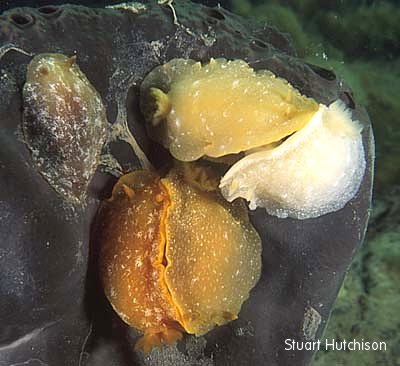
Dear Bill,
I'm not sure what these guys are, but you can see the great diversity in colour. They also seem to have white tubercles or 'blotches' all over their backs too. I actually moved four of the five animals to the same sponge - from very close by. There were literally dozens of them around and several were on different coloured sponges. They were located in Whyalla (South Australia) in 3-4m water on mossy/weedy rock. They were an average size of about 2 inches (50mm) as the larger ones in these photos. They were photographed this month (August 2000).
The two at bottom left are mating.
I thought perhaps Neodoris chrysoderma or Doriopsilla carneola - but I have more distinctive shots of those types from around here - I will send those soon.
Stuart Hutchison.
hutchco@tpg.com.au
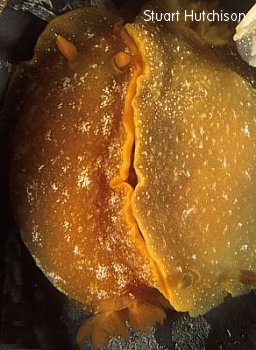
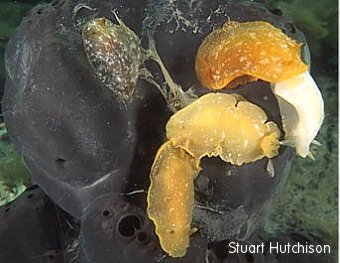
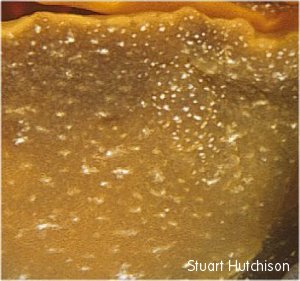
Dear Stuart,
I am pretty sure that these are Dendrodoris carneola which is distinguished by the closely spaced small papillae all over the mantle, which as you can see in the close-up I have included alongside, exude a white secretion when disturbed.
It would be good to see a few photos of them on the actual sponges they were on to see if there was any relationship between their colour and the colour of the sponges.
I have used the genus name Dendrodoris as a temporary because until we have a clearer understanding of the anatomy of the Australian dendrodorid species, and the differences between Dendrodoris and Doriopsila.
Best wishes,
Bill Rudman.
Dendrodoris aurea and D. carneola
March 15, 2000
From: David Freemantle
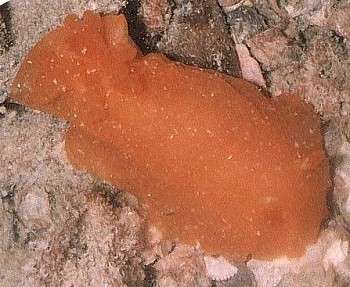
Just inquiring about the differences between Dendrodoris aurea & D. carneola, as they are too similar for me to distinguish between them (as seen in Sea Slugs of WA). Please find attached 3 images, taken at 3 different locations (2 from Cockburn Sound, Western Australia & the bottom left from Rye, Victoria). I assume they are all "D. carneola" (as it is probably more common), or are they?.
Thanks for your help
David Freemantle
scubadav@rock.upnaway.com
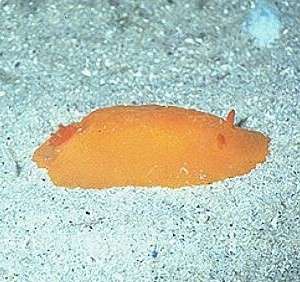
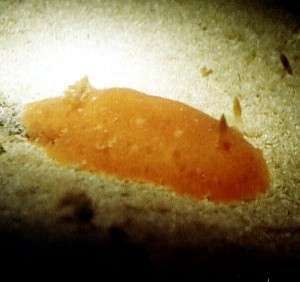
Dear David,
I am pretty sure your animals are Dendrodoris carneola which ranges in colour from deep reddish-brown to translucent white, although it is usually either orange or red. There are often, but not always, scattered white specks on the mantle.
Dendrodoris aurea is usually a bright yellow colour, but also ranges from dark red to translucent white. It differs in having low rounded pustules over the mantle and no white specks. It is very similar externally to Neodoris chrysoderma but in that species the pustules are usually a lighter colour and the head is typical for the Eudoridoidea rather than the very reduced head typical of a dendrodorid.
I have added pages on both species for you to compare.
Best wishes,
Bill Rudman.
Dendrodoris spp
March 15, 2000
From: Bill Rudman
I have added pages on Dendrodoris miniata, Dendrodoris aurea, and Dendrodoris carneola and upgraded Dendrodoris citrina to help in answering Dave Freeman's message.
Bill Rudman.
